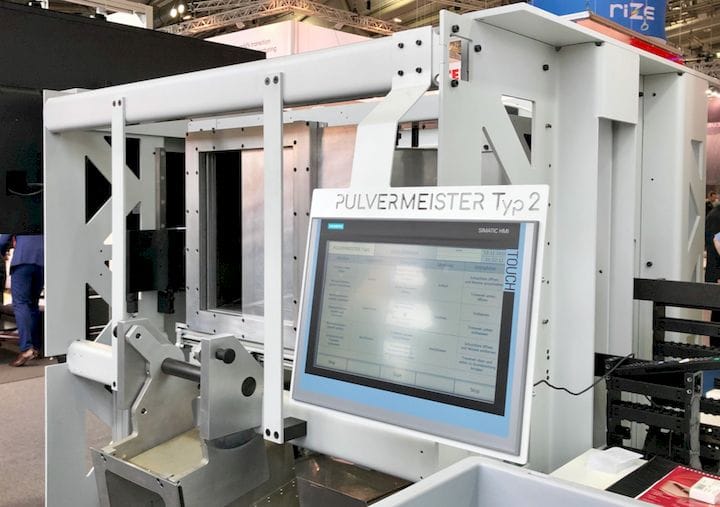![The PULVERMEISTER Typ2 post-processing device [Source: Fabbaloo]](https://fabbaloo.com/wp-content/uploads/2020/05/image-asset_img_5eb09e6e05854.jpg)
A new company, PULVERMEISTER GmbH, has produced a prototype of a 3D print post-processing device.
The two-year-old company focuses on SLS 3D printing operations, as their integrated Typ2 machine is able to perform two key post-processing functions: depowdering and finishing.
Traditionally these post-processing steps are done manually. Removing powder is often done at a special workstation that includes a manually directed air blower (a wand, usually), and powder is captured for potential re-use in subsequent prints. Smoothing is done using jiggly devices where specialized media is continuously but gently bumped into the prints. This gradually wears down the surface texture to a smoother appearance.
Recently there have been some developments in this space, as the number of companies using SLS 3D printers increase due to price drops and demand. This has created a greater need to automate the previously manual post-processing steps.
A couple of companies that offered manual equipment have now started moving towards more integrated and automated solutions, where there is less manual labor required.
However, PULVERMEISTER seems to be a new startup that is moving immediately towards this type of solution.
Their Typ2 device is the manifestation of their concept. It performs the two functions in one device.
![Fully finished SLS 3D prints done by Pulvermeister’s Typ2 [Source: Fabbaloo]](https://fabbaloo.com/wp-content/uploads/2020/05/image-asset_img_5eb09e6e6fd5a.jpg)
The machine design is interesting, as it involves two separate, but occasionally adjoining, containers. The upper container is used to depowder the prints, and it accepts the entire contents of a typical SLS print job directly. They say the typical usage is for the output of an EOS P110 machine to be placed in the upper chamber.
The depowdering process is quite rapid, taking only approximately 10 minutes for a typical operation. During this process the upper chamber slowly rotates in different directions to shake loose any stray powder. Recovered powder flows back to a recovery bin, but is not exposed when doing so.
When the first stage, depowdering, is complete, the upper chamber rotates and drops the clean parts into the lower chamber for smoothing. This chamber would be loaded with whatever media is appropriate for the particular job requirements.
When smoothing is completed, apparently in about 40 minutes duration, the lower chamber is rotated again and the finalized parts are dropped into a collection bin, ready to be used.
You can see the entire process in their introductory video here:
It’s not clear whether the Typ2 device is yet for sale, nor are prices available, but it is under development. What is interesting to me is the attention being paid to this increasingly important aspect of 3D printing: post-processing.
I expect that over time we will gradually see all manual steps involved in 3D printing fully automated, or as much as is possible, with companies like PULVERMEISTER driving the industry forward.
Via PULVERMEISTER











